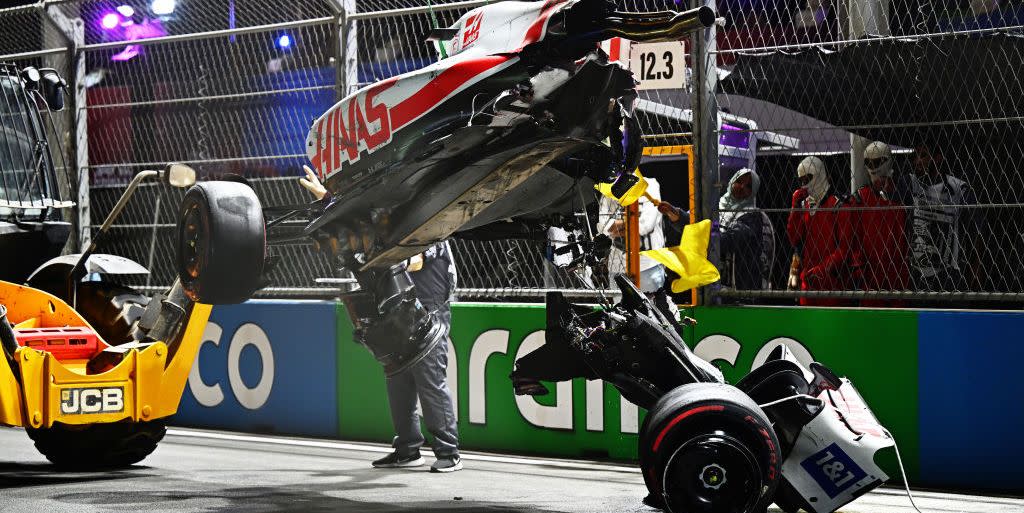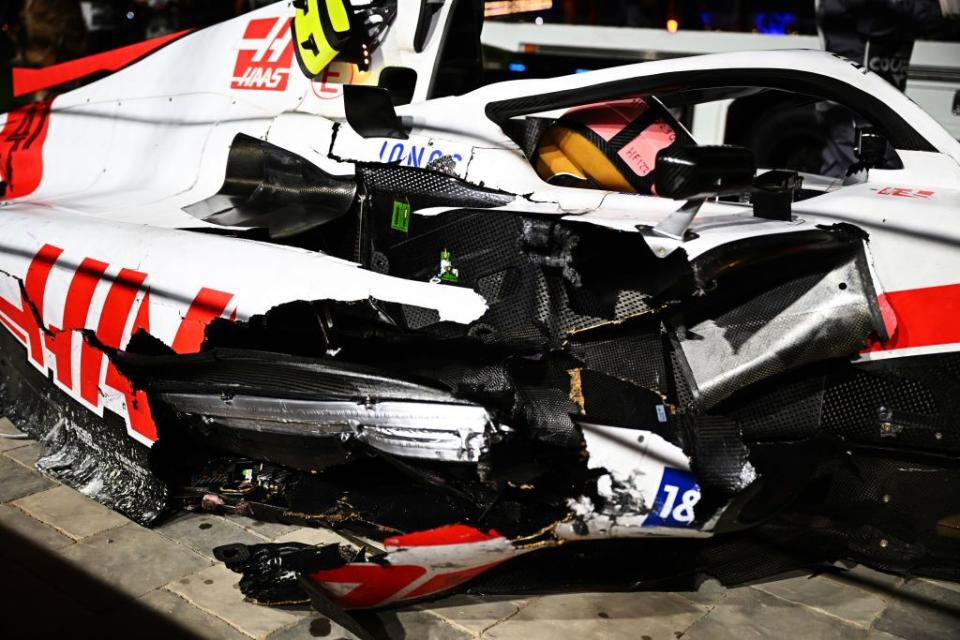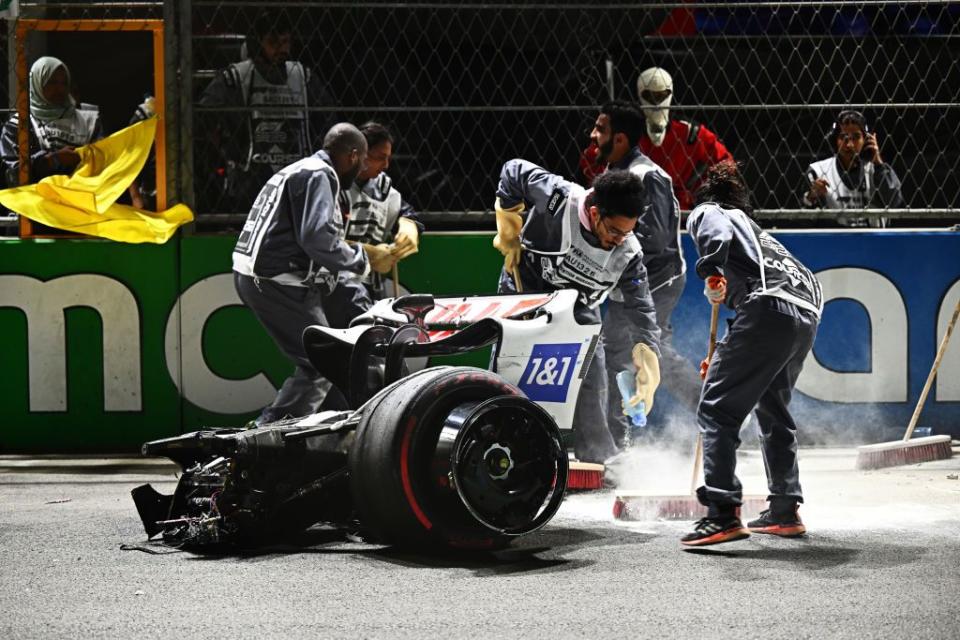How Formula 1 Teams Put a Car Back Together after a Crash

- Oops!Something went wrong.Please try again later.
Haas team principal Guenther Steiner estimates it costs the team between $500,000 and $1 million when one of the team's F1 cars goes hard into the wall.
Aside from the financial damage it also creates an extra workload for the team.
Mick Schumacher’s accident in Jeddah “was one of the big ones, no doubt about it” and it registered over 40 g's.
How do you rebuild a wrecked F1 car?
Formula 1 cars are assembled every Thursday at a race weekend and then stripped down on Sunday night for the journey to the next venue. However, sometimes in between even the best of plans, there can be a wrench thrown into the works when a driver puts the car into the wall.
The most recent prominent example in Formula 1 came in Saudi Arabia, when Haas F1 Team driver Mick Schumacher suffered a violent accident during qualifying, causing severe damage to his VF-22. Haas team principal Guenther Steiner estimated it cost the team between $500,000 and $1 million (Steiner said this one was closer to $1 million), but aside from the financial damage it also created an extra workload for the team.
On that occasion, Haas opted not to rebuild his car for the race, citing the risk of compromising its Melbourne prospects. Ultimately, the team will put the car back together again and make it ready to race.
It is a process that takes some of the best mechanics in the world.
“Naturally the first thought (after a crash) is about the driver, and you hope he’s okay—he’s part of the team,” said Matt Scott, chief mechanic for the Haas team, on when a big accident happens. Once the green light has been given by the medics then attention swiftly turns to the work at hand.
“Our first idea of the state of the car is what we see on the TV shots,” said Scott. “The horrible shots of when the car is picked up and the whole rear drops off, or they’re lifting barriers out of the way and bits of car are missing. And it’s like ‘ooh, argh.’ You can then start preparing the bits you require.”
Schumacher’s accident in Jeddah “was one of the big ones, no doubt about it” and it registered over 40 g's. Once the car is returned to the team. then an inspection can be undertaken to assess the level of damage.

“You can have components that look okay, but aren’t okay, or they might have been tweaked out of shape or had internal damage. Anything going through 40-g is going to have to go through a rigorous inspection process. You strip the car down, anything that’s obviously recoverable—non-structural carbon parts—that look fine, we are happy to use. Anything mechanical that has taken a high load—which we can see from the data that we have available—will be quarantined and returned to our base in Banbury, where we’ll do NDT (Non-Destructive Testing) inspections.”
That test decides whether the part is fine, can be repaired, or if it must be scrapped entirely. As the components are expensive, and Formula 1 exists in a cost cap environment, there is due diligence before parts are considered completely worthless. One struggle early in the year can be with spare parts—as there hasn’t been the time to have the spares made to get them in stock—and thus sometimes compromises have to be made. However teams do usually travel with several spare parts, including spare chassis, as accidents are part of racing.
For a team such as Haas their work will be mirrored by power unit supplier Ferrari, which provides a gearbox technician and engine technician for each car. Usually in a major accident the original components will be removed, and taken back to Maranello for checks, with the spares used, as the equipment and tools needed for such an inspection can’t be carried around the world.

Post-accident the biggest element is whether the chassis—ie, the basic structure of the car— made it out intact. If yes, that saves mechanics a lot of work. If not, there’s a big job on hand.
“When you have an accident when you change the chassis you’re talking about the fuel system,” Scott says. “It’s inside the survival cell, and if you’ve got damage inside there then you have to start removing components and it becomes very time consuming. We are prepared for accidents, so you can have various sub-assemblies built, which makes it easier, but when you get into sub-assembles of some components that gets very time-consuming.”
If the chassis has been cleared then it becomes a more straightforward task for the mechanics. The damaged car is stripped down methodically and can then be rebuilt.
“You start at the chassis and build up from that—front suspension, engine, the rear suspension and gearbox can be built together, that goes on the back of the engine, then the floor and the bodywork.”
Every person within the team has specific roles and responsibilities. They know what they’re doing and have an order in which it is done. Checks are then undertaken once complete, such as on the fluid systems and power unit, to ensure all of the data is as expected.
For the mechanics, the added workload that comes with crash damage is undoubtedly undesired but it allows them to demonstrate their skill set.
“It’s exciting, like the driver going out into qualifying, they’re doing their best—going for the fastest lap time,” said Scott. “And we’re there to build the car. And when you get into the situation where you have to deal with stuff—that’s when you feel you can make a big difference by pushing as hard as you can.”
And that's how you put Humpty Dumpty back together again.
Mick Schumacher will miss the Saudi Arabian GP after a huge accident in qualifying.
That Mick is physically well after the crash is another reminder of the strength and safety of modern F1 cars for which we are incredibly thankful#SaudiArabianGP #F1 pic.twitter.com/qhLcw0elb7— Formula 1 (@F1) March 26, 2022

